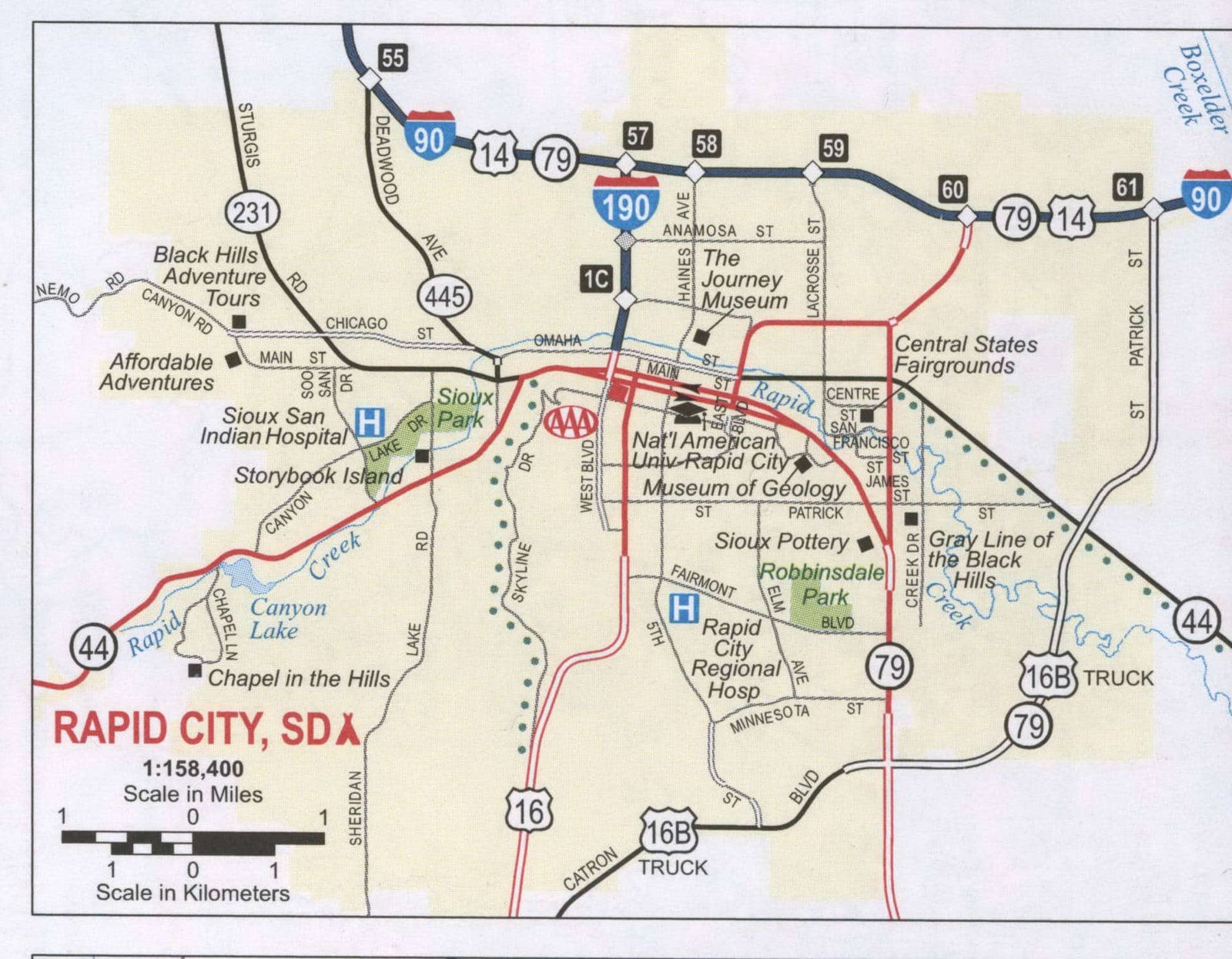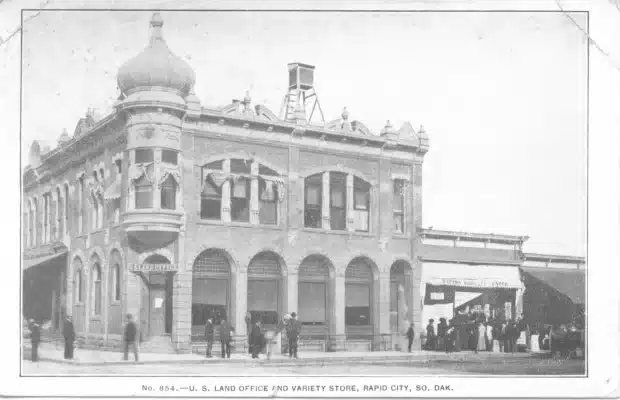Rapid City, South Dakota
A city in western South Dakota, Rapid City is situated in the Black Hills foothills. As of the 2020 census, it had a population of about 77,000, making it the second-largest city in the state.
The outdoor recreation options in Rapid City, which include skiing, hiking, biking, and camping, are well-known. The city is also home to a number of well-known tourist destinations, including the Badlands National Park, Crazy Horse Memorial, and Mount Rushmore National Memorial.
The South Dakota School of Mines and Technology, the Rapid City Regional Airport, and the city’s historic downtown are some of Rapid City’s other noteworthy attractions. The city also hosts a number of festivals and annual events, such as the Sturgis Motorcycle Rally, the Black Hills Stock Show and Rodeo, and the Black Hills Powwow.
Geography Of Rapid City

Map of Rapid City, SD
Western South Dakota is where Rapid City is situated in the United States. It is located at a height of about 3,200 feet above sea level in the foothills of the Black Hills mountain range.
The area of the city, which is in Pennington County, is approximately 55 square miles. On the banks of Rapid Creek, a tributary of the Cheyenne River is where Rapid City is located.
The Harney Peak, which rises to a height of 7,242 feet above sea level, is the highest point of the Black Hills mountain range, which dominates the area around Rapid City. Rolling hills, pine forests, and grassy plains define the region around Rapid City.
The city is situated at the junction of a number of important roads, including U.S. Route 16 and Interstate 90, which run north-south and east-west through the city respectively. Just outside the city, the Rapid City Regional Airport offers commercial air service to a number of locations across the country.
Rapid City Economy
The economy of Rapid City is varied and made up of a variety of sectors, including healthcare, tourism, education, manufacturing, and retail. The city’s three biggest employers are Ellsworth Air Force Base, the healthcare industry, and the Rapid City Area Schools.
Rapid City’s proximity to several well-known tourist attractions, including Mount Rushmore National Memorial, Crazy Horse Memorial, and Badlands National Park, makes tourism another important industry in the city. There are numerous hotels, eateries, and other tourist-oriented businesses in the city.
Rapid City’s manufacturing sector includes companies that manufacture a wide range of products such as electronics, medical devices, aerospace components, and construction materials. The city is also home to the South Dakota School of Mines and Technology, which produces a steady supply of skilled graduates in engineering and other technical fields.
Rapid City’s retail sector is also significant, with several shopping centres and malls scattered throughout the city. Rapid City’s proximity to the Black Hills also provides opportunities for outdoor recreation-related businesses such as ski resorts, outfitters, and outdoor equipment retailers.
Climate Of Rapid City
Rapid City’s climate is semi-arid, with four distinct seasons. Summers are typically warm to hot, with temperatures ranging from the mid-80s to the low 90s Fahrenheit Winters are cold and snowy, with temperatures ranging from the mid-20s to the low 30s Fahrenheit . Spring and autumn are typically mild and pleasant, with sporadic bouts of rain and thunderstorms.
Rapid City receives approximately 18 inches of precipitation per year, the majority of which falls during the summer months. Snowfall averages 42 inches per year, with the majority falling between November and March.
Rapid City is prone to severe weather, such as thunderstorms, hail, and tornadoes, due to its location in the Black Hills foothills. However, these occurrences are uncommon in comparison to other parts of the Great Plains region. The city also experiences winter storms on occasion, which can cause travel disruptions and other hazards.
History Of Rapid City

Rapid City, South Dakota – Land Office – old history
Rapid City’s history dates back to the late 1800s when a group of settlers arrived in the area in search of gold. The city was established in 1876 and was named after the nearby Rapid Creek, which runs through it.
Rapid City was once a supply and transportation hub for the surrounding mining towns, including Deadwood and Lead. The city was also a major stop on the Chicago and North Western Railway, which transported goods and passengers to the region.
The United States Army established an airbase near Rapid City in 1941, which later became Ellsworth Air Force Base. The base was important to the local economy and helped to stimulate growth in the area.
Rapid City was hit by a devastating flood in 1972, killing over 200 people and causing extensive damage to the city’s infrastructure. The disaster prompted extensive rebuilding efforts as well as the construction of a new flood control system, which helped to protect the city from future floods.
Rapid City is now a thriving metropolis with a diverse economy and a rich cultural heritage. Several museums and cultural institutions can be found in the city, including the Journey Museum and Learning Center, the Museum of Geology, and the Dahl Arts Center. Rapid City also hosts a number of annual festivals and events, including the Black Hills Powwow, the Black Hills Stock Show and Rodeo, and the Sturgis Motorcycle Rally.
Rapid City and nearby Attractions
Rapid City is close to a number of popular tourist attractions, including:
- Mount Rushmore National Memorial: A national monument carved into the side of a mountain with massive sculptures of four United States presidents.
- Crazy Horse Memorial: A massive sculpture of Crazy Horse, an Oglala Lakota warrior, that is still under construction.
- The Badlands National Park is a beautiful national park with eroded rock formations, canyons, and grasslands.
- Wind Cave National Park: A national park with a large cave system and a variety of wildlife.
- Custer State Park: A state park with scenic drives, hiking trails, and wildlife viewing opportunities.
- The Black Hills National Forest is a large forested area that offers hiking, camping, and other outdoor recreation opportunities.
- Jewel Cave National Monument is a national park with a massive underground cave system.
- Reptile Gardens: This is a large reptile zoo and botanical garden with exotic animals and plants.
- The South Dakota Air and Space Museum is a museum dedicated to aviation and space exploration.
Related Articles

Facts About Rapid City, SD

Rapid City, South Dakota (1)




